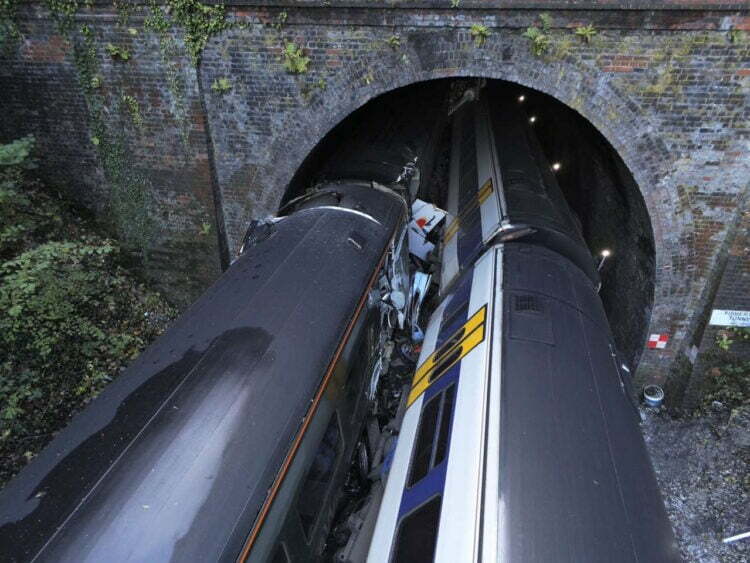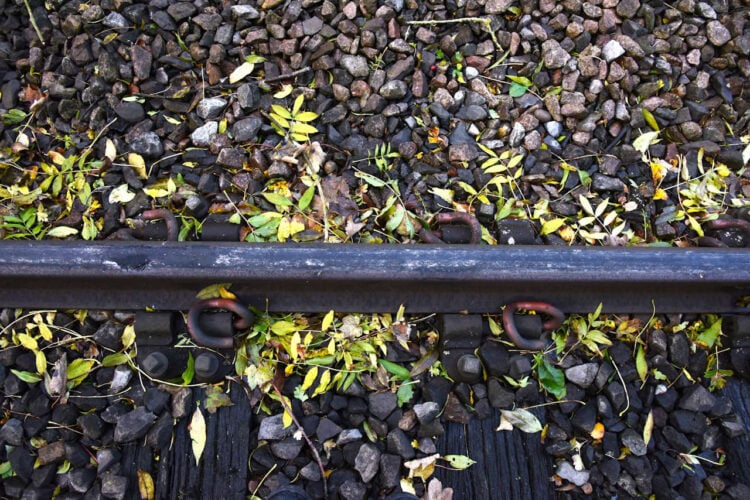The Rail Accident Investigation Branch (RAIB) has issued its report into a collision between two passenger trains at Salisbury in October 2021.
The incident happened at Salisbury Tunnel Junction in Wiltshire, which is on the immediate approach to Fisherton Tunnel, at around 18:43 on 31 October 2021 when the 17:20 South Western Railway service from London Waterloo to Honiton passed a red signal and collided with the side of 17:08 Great Western Railway service from Portsmouth Harbour to Bristol Temple Meads.

When the trains collided, the South Western Railway train was travelling at approximately 52 mph and the Great Western Railway train at 20 mph, causing the front two carriages of the Waterloo train and the rear two carriages of the Portsmouth Harbour train to derail.
Both trains continued to travel into Fisherton Tunnel before they came to a stop.

As a result of the accident, 13 passengers and one member of the railway staff required hospital treatment, and there was also significant damage to the trains and railway infrastructure.
Investigations found that the causes of the accident were;
- wheel/rail adhesion was very low in the area where the driver of the Waterloo train applied the train’s brakes;
- because of the prevailing low level of adhesion, the driver did not apply the train’s brakes early enough to avoid running on to the signal protecting the approach to the junction;
- the braking systems of the Waterloo train could not cope with this very low adhesion.

Leaf contamination on the railhead had caused a very low level of wheel/rail adhesion and was made worse by a drizzle falling immediately before the passage of the Waterloo train.
RAIB’s investigation found that there was also an increased amount of vegetation in the area that had not been effectively managed by Network Rail’s Wessex route and was probably an underlying factor.
It had also failed to use proactive or reactive measures to effectively manage railhead contamination.
RAIB also discovered that another underlying factor was that South Western Railway was not suitably preparing its drivers for assessing and reporting low adhesion conditions.
RAIB also made two safety observations:
- the application of revised design criteria for the Train Protection and Warning System;
- the risk of signal overrun and how it accounts for a high risk at low adhesion sites should be assessed.
Two issues were found relating to the severity of the incident:
- loss of survival space in the driver’s cab of the Waterloo train;
- jamming of internal sliding doors resulting in obstruction of passenger evacuation routes.
Network Rail has since reviewed its training and competence framework for off-track staff and is reviewing its adhesion management standards, whilst its Wessex route is reviewing arrangements for proactively responding to reports of low adhesion and how it undertakes railhead treatment.
South Western Railway has changed the training and briefing of its drivers so that they are effectively briefed on and understand information about autumn arrangements.
Network Rail and South Western Railway have also jointly updated their annual autumn leaf fall working arrangements to ensure that sites at high risk of low adhesion are identified, reassessed, managed and monitored.
The rail industry standard that provides guidance regarding the management of low adhesion has been revised by the Rail Safety and Standards Board, and cross-industry working groups have issued revised guidance regarding low adhesion.
In December 2021, the Office of Rail and Road (ORR) issued Network Rail s Wessex route with an improvement notice requiring it to improve its vegetation management and how it assessed and controlled low adhesion risks.
RAIB has made ten recommendations, of which seven have been made to Network Rail for it to review:
- processes, standards, and guidance documents that relate to the management of leaf fall low adhesion risk;
- the training and competence of staff dealing with vegetation management and seasonal delivery;
- responses to emerging and potential railhead low adhesion conditions;
- management of railhead treatment regimes;
- assessing the risk of overrun at signals at sites with a high risk of low adhesion on their approach;
- the retrospective application of design criteria for the Train Protection and Warning System.
One recommendation is made to South Western Railway:
- review and improve its arrangements for training and briefing drivers to make sure they can effectively identify areas of low adhesion and report them as necessary.
One recommendation is made to the Rail Delivery Group:
- in consultation with train operators and the Rail Safety and Standards Board, to improve braking in low adhesion conditions, investigate technologies other than sanding systems and wheel slide protection.
One recommendation is made to Porterbrook, Eversholt and Angel Trains:
- Investigate the design of the internal sliding doors on class 158 and 159 carriages.
Andrew Hall, Chief Inspector, Rail Accident Investigation Branch said: “This was a very serious accident and the first time since our inception in 2005 that RAIB has investigated the collision of two passenger trains travelling at significant speed. Fourteen people were taken to hospital, including two who were seriously injured.
“The phrase ‘leaves on the line’ may cause some to smile. But the risks associated with leaves being crushed onto the top of rails by the pressure of train wheels, resulting in a slippery layer, is very real and long known. As with many accidents, this one resulted from a combination of many different circumstances coming together, both in the time before the accident and on the day. As a result, the barriers put in place to avoid this type of event did not work effectively.
“Accidents like this are thankfully very rare, but it is vital that we learn the lessons when things do go wrong. Along with action already taken by industry, the ten recommendations we have made today will minimise the chances of an accident like this happening again.”





Responses
Was the age of the SWT driver a factor ? Experience v reaction timing ?
Even with brake blocks problems occurred on certain routes but nothing like disc brakes which led to a massive increase into wheel slide. Initially Drivers got blamed then realisation of the very serious problem created the present Rail Head Treatment trains at great expense.
On the Catford Loop in the 1970’s, with brake blocks, between Swanley and Sevenoaks a classic route where trees prevailed making braking difficult and starting away in the Autumn. As for braking an Old Hand Driver told me if you start sliding on an EPB reduce the braking and open the power handle to notch one to attempt to get the wheels revolving again. The smoke and smell was unpleasant, the result though, effective. Those old units withstood any amount of bad treatment without undue damage.
Surprising that the change to disc brakes on modern trains, instead of brake shoes bearing on the wheel treads was not mentioned. I had understood that wheel tread brakes had a side effect of cleaning the wheel treads thus helping adhesion, whereas disc brakes do not keep the wheel treads clear of leaf mulch buildup. I wonder is this contrbuted at all to this accident?
So much for privatization!
Corners are cut to appease the shareholders ,the only privatized railway in Europe and the most expensive.